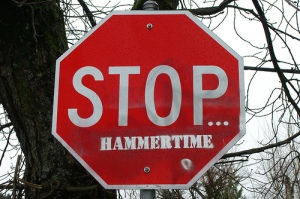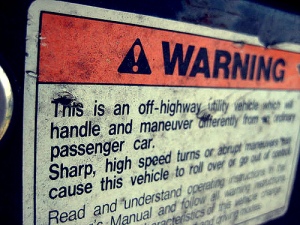MC Hammer and building a community on Twitter

pic from Flickr user 'EMS Shane in Portland'
The online journalism module I have taken at Cardiff University this past term has consisted of a series of weekly lectures, which in turn have led to numerous technological epiphanies. These have tended to happen when I least expect them and the latest one, concerning the utility of Twitter, occurred earlier this month in the middle of a lecture by BBC Technology Correspondent Rory Cellan-Jones.
As he went through an informative power point slide show, Rory’s Twitter feed popped up regularly on the projector screen. At the beginning of the lecture, we were told via Twitter that Roy Keane had parted company with Sunderland. A little later on, while we were watching a video clip, he sent out a tweet asking the members of his network to advise us students on how to succeed in journalism. At the end of his address, he gave us the edited highlights of these recommendations.
It was at some point during this session that I felt the thud of the Twitter penny dropping. Twitter is worlds apart from traditional forms of static news: clearly a newspaper article can delve much deeper than a 140 character tweet, but in an unobtrusive and unparalleled way, Twitter can supply useful, short snippets of information. The lecture would have been absurd if Rory had delivered it with a radio or a TV blaring away in the background, but the gentle and frequent ping of his Twitter feed provided both him and us with information updates, and in doing so enhanced the lecture rather than disturbing it.
Since the lecture I’ve been having a look at what Twitter could be useful for, and I think it can be summed up in one word: communities. It took me a while to realise, as Kate Carruthers neatly puts it in her blog, that “Twitter is real life.” In a significant way, Twitter trumps any search engine because it allows you to easily reach out to real people and build communities of interest, and tap into communities that already exist in the real world. In this sense, Twitter can both build and enhance communities.
Internet users’ control over the rubbish than pollutes much of the web is limited, but Twitter users have complete control over whose feeds they follow. The networks they can build on Twitter are arranged entirely to their own preferences, and this means that information can potentially be sourced more smoothly than through the electronically educated guesses of search engines, as Rory Cellan-Jones demonstrated. This notion of community is best shown using a couple of examples:
Musical Communities

pic from Flickr user 'jamesgrayking'
I found out this week that Oasis have started their own Twitter feed to deliver specialised news to their online community. Clearly it is operated by someone else on their behalf, but it gives a strong indication of the perceived power of Twitter if the music industry is starting to use it as a marketing platform. Other musicians have twigged too. Muse were there even earlier than Oasis. Bjork is also represented but her feed needs some attention – as fittingly kooky as it is, it largely consists of thanking people for following her. Last, and certainly not least, Twitter users can ensure it is hammer time every single day by following MC Hammer’s busy personal feed.
Early Warning Communities

pic from Flickr user 'Jessica Driver'
Twitter communities do not have to be global; they can also be local and practical. In a breakthrough which he calls “Tube 2.0”, Tom Morris has created Twitter feeds for all of the individual lines on the London Underground telling followers of current and future problems on each relevant track. Simon Whitaker has experimented along similar lines, providing traffic updates for various motorways and regions in the UK through Twitter feeds. Jeff Jarvis has blogged on the wider use of Twitter as an early warning system in a news-gathering sense, saying it could be the “canary in the news goldmine.”
Looking a little deeper at these two examples of Twitter communities is illuminating. The total number of Twitter users is difficult to ascertain, but was recently estimated to be between 3.5 – 4.5 million and is certainly growing all the time. That makes the number of followers of some of the feeds I have mentioned seem a little puny. The page made by Tom Morris for the busiest Tube line – Victoria – only has 74 followers despite having posted 536 updates since February last year.
Muse’s Twitter feed has been open since the end of May this year, and after posting 25 updates since then, the page has amassed 2,239 followers. Again this is fairly unimpressive, but given the slow rate of updates it is unsurprising. The contrast with MC Hammer’s feed is marked: he has almost 14,500 followers, and has posted 1,417 updates at the rate of around three per day. Many of his tweets are responses to issues raised by his followers.
MC Hammer provides important lessons for building a successful community on Twitter: make sure that the feed is updated regularly, and make sure it is a two way street of communication rather than a list of announcements or links to a parent website. I’ll let MC Hammer have the last word. He deserves it.
